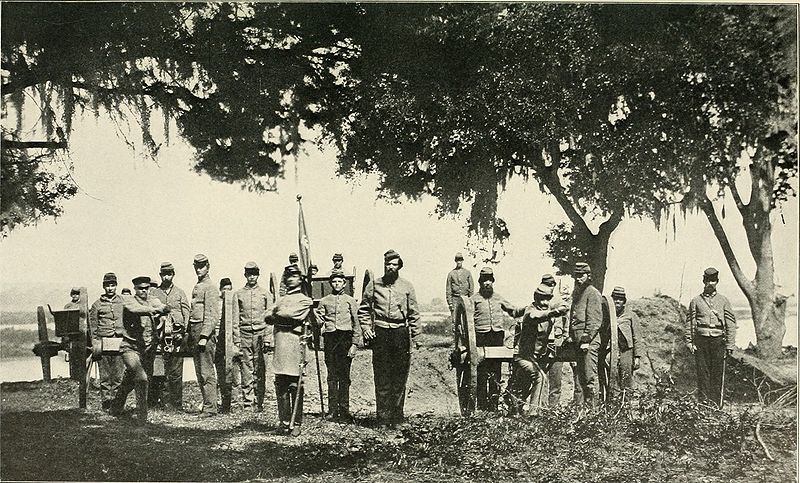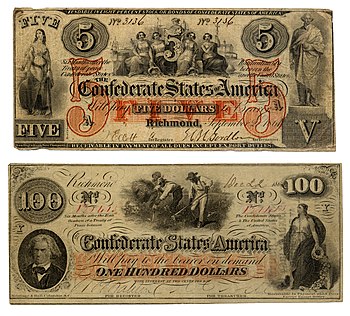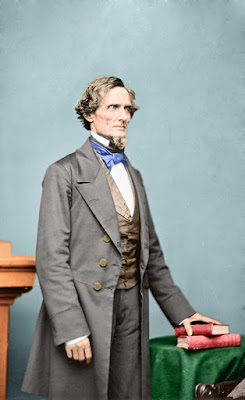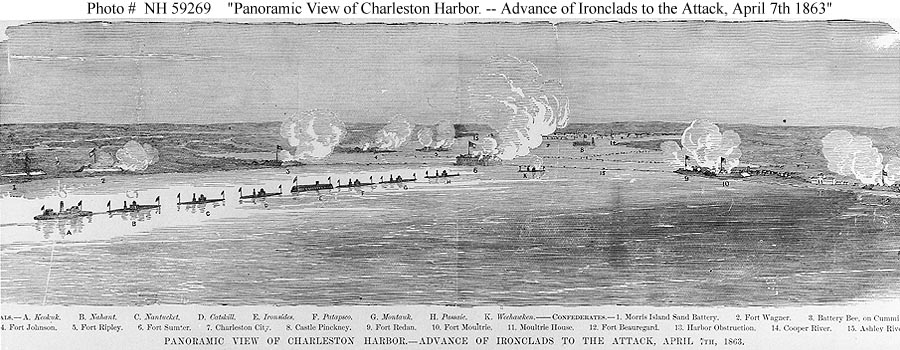Tuesday, April 30, 2013
Lee Moves to Counter Hooker
It wasn’t long after Joseph E. Hooker crossed the Rapidan that Robert E. Lee got word of the movement. He was in a dangerous position – three Union corps were moving to his flank, while he was still facing a large Union force at Fredericksburg. Most generals in this position would have instantly decided to retreat, but not Robert E. Lee. He would go on the offensive. He decided to leave a skeleton force of 10,000 men to watch Sedgwick at Fredericksburg, while he moved with the other 50,000 men of the army to crush Hooker around Chancellorsville. The Confederates would begin moving on April 30th, 150 yeas ago today, and only the next day the armies would meet in the thickets of the Wilderness.
Monday, April 29, 2013
Bombardment of Grand Gulf
As the Union troops under Grant worked to capture the Confederate
stronghold of Vicksburg on the Mississippi, their next obstacle would
be Grand Gulf. The Union transports had run the formidable Vicksburg
batteries with little losses, and the army had marched around on the
western shore. Now Admiral David Porter with seven ironclads would
attempt to silence the Confederate batteries at Grand Gulf, which
commanded the Union’s planned beachhead, and then capture them with
the troops of John McClernand.
The
Union ironclads went out to battle at 8:00 am on April 29th,
150 years ago today. Four of the boats would engage the lower
Confederate battery of Fort Wade, and after subduing the rebel guns,
they would join the other three ironclads in fighting the upper battery,
Fort Cobun. Advancing to within 100 yards, the Union ships opened on
the forts. The fight continued until 1:30 pm. The ironclads were
successful in subduing Fort Wade, but were unable to achieve the same
success at Fort Cobun. The ships took heavy damage. The USS
Benton
took one shot which killed or injured 25 men. Her steering crippled
by a shot to her pilot house, she floated downstream. Seeing the
Benton’s
danger,
Acting
Volunteer Lieutenant Hoel of
the Pittsburg
maneuvered his ship to cover the Benton,
taking the fire from the fort while the Benton
could
be secured.
After five and a half hours of combat and 80 men lost, Porter decided
that it was impossible to capture Grand Gulf. This Confederate
victory was only a temporary setback for the Federals. It wasn’t
long before the infantry crossed further downstream, and Grand Gulf
had to be abandoned when threatened from the rear.
Labels:
battle,
David Porter,
Mississippi,
Ulysses S. Grant,
Vicksburg
Sunday, April 28, 2013
Hooker Begins His Campaign
 |
| Hooker's Plan for the Campaign |
General Joseph Hooker, commander of the Union Army of the Potomac, did not want to make the same mistake as Burnside had at the Battle of Fredericksburg in December. So he would not try a direct attack on the entrenched Confederates. This left him with two options - he could either cross the Rappohannock above, or below Fredericksburg. He chose to cross above so he could continue to cover Washington to prevent Lee from making a quick rush at the city. His plan was for George Stoneman to cross with the cavalry thirty miles north of Fredericksburg and sweep into Lee's rear, riding over JEB Stuart's outnumbered troops, and spreading havoc in rebel communications. The infantry corps of Slocum, Howard and Meade would then cross at Kelley's Ford. This ford appeared to be unguarded, and he hoped that he could cross and get in Lee's rear before his presence was discovered. As this Union force advanced south they would uncover Bank's Ford, where Couch's Corp would cross. Meanwhile Sedgwick, Reynolds and Sickles would cross just south of Fredericksburg, where Jackson had fought in December's battle, to hold those Confederates in place. If Hooker's plan worked as he hoped, he would envelope Lee and give him no choice but to fight on the ground of Hooker's choosing. "My plans are perfect," Hooker declared, "and when I start to carry them out, may God have mercy on Bobby Lee, for I shall have none."
Hooker had his men moving the last week of April, getting into position to cross the river. The cavalry was late in starting, and failed to cause the confusion in the southern plans that Hooker hoped for. The infantry crossed the river on the night of April 28th, 150 years ago today. The Union troops concentrated in an area called the Wilderness around a crossroads called Chancellorsville. The Wilderness was a large jungle of woods and underbrush that was destined become the scene of the bloodiest battles in Virginia. Hooker soon had four corps concentrating in the area, with another one, Sickels, on the way from the left. It seemed that everything was going perfectly in the Federal favor. Hooker proclaimed on April 30th:
 |
| Hooker |
It is with heartfelt satisfaction the commanding general announces to the army that the operations of the last three days have determined that our enemy must either ingloriously fly, or come out from behind his defenses and give us battle on our own ground, where certain destruction awaits him. Lincoln remained sceptical. He had heard this talk before, particularity from John Pope, who had been whipped by Lee at 2nd Manassas. He commented, "The hen is the wisest of all the animals in creation because she never cackles until the egg is laid." Hooker’s plans would fall apart when Lee responded with one of Lee’s most daring plans of the entire war.
Labels:
campaign,
Joseph Hooker,
Robert E. Lee,
Virginia
Wednesday, April 24, 2013
Lincoln Approves the Lieber Code
 |
| Francis Lieber |
Although the code was issued as only an order for the United States
army, it was eventually adopted by the Confederacy, and other armies
across the world. It became one of the foundational expressions of
the international laws of war. It said that war was between
societies, so that civilians of the opposing nation were indeed
enemies, but it also said that they should be spared whenever
militarily possible. It also established rules for dealing with
captured property, both public and private, spies, deserters. You can
read the entire order here.
Labels:
Abraham Lincoln,
Congress,
politics
Wednesday, April 17, 2013
Grierson’s Raid
 |
| Grierson and his staff |
At first glance, Colonel Benjamin Grierson would not be considered an ideal cavalry officer. Before the war he had been a music teacher, and he hated horses after he was nearly killed by one at the age of eight. Nonetheless, his raid was very successful. He rode on routes not yet touched by Union armies, tearing up railroads, destroying stores and freeing slaves. Along the way he set off smaller unites to distract his pursuers. One of the reasons he did so well was because of a lack of major Confederate pursuit. Nathan Bedford Forrest was busy dealing with another Union raid, that one under Abel Streight.
 |
| Grierson's men on their raid, taken by a Confederate scout |
Grierson brought an end to his raid on May 2, 1863, when he arrived at Baton Rouge, Louisiana. He had lost only three killed, seven wounded, nine missing, and five who fell sick and had to be left behind. Grierson would go on to rise to the rank of Major General later in the war, obtaining more successes as a cavalry officer.
Labels:
campaign,
cavalry,
Mississippi,
raid
Tuesday, April 16, 2013
Porter Runs the Vicksburg Batteries
 |
| Porter |
On the night of April 16th, David Porter was ready to try to sail his ships past the batteries. They were covered so they would be completely dark, and strict orders were given to make no noise. They would move slowly so their engines would not be heard. This plan started off working well. The boats were opposite Vicksburg before they were sighted. But, when they were discovered, the Southern guns opened on them with a tremendous fire. For ninety minutes the Confederates fired every gun they could, firing off over 500 shots. Even with all this resistance, Porter's fleet successfully ran the batteries. Most ships sustained only minor damage, though one transport was sunk. Altogether, it was a great success. Although one ship had been lost, no one had been killed and only 13 wounded. After receiving some repairs, the ships would be ready to transport Grant's men. A few more ships were sent through the next night, and, as before, all made it through except one.
Labels:
battle,
campaign,
ironclad,
Mississippi,
Mississippi River,
Vicksburg
Sunday, April 14, 2013
Queen of the West Sinks
150 years ago today the Queen of the West was destroyed in an engagement on the Atchafalaya River in Louisiana. The Queen of the West was originally fitted out as a warship by the United States government. After running the Vicksburg she was abandoned by the Federals while assaulting Fort DeRussy, and was captured by the Confederates. She was used as the CSS Queen of the West by the Confederates, and assisted in the capture of the ironclad USS Indianola. However, her career would come to an end on April 14th, when she was attacked by three Union steamers, the USS Arizona, Calhoun, and Estrella. The cotton on board the Confederate steamer caught fire from a long range Union shot, and the ship burned to the water line and sank.
 |
| Destruction of the Queen of the West |
Labels:
battle,
Confederate Navy,
Louisiana,
navy
Saturday, April 13, 2013
Battles of Fort Bisland and Irish Bend
 |
| Banks |
 |
| Richard Taylor |
Taylor would spend April 13, 150 years ago today, fighting off Bank’s forces to his front. Then, realizing he was nearly trapped, he would pull out during the night. He would fight another battle the next day, this time against Grover. While his trains were pulling out he held on in the Battle of Irish Bend. His trains having pulled back, Taylor successfully made his escape. Grover lost 353 men. Taylor’s casualties were less, but not known with certainty.
Labels:
campaign,
Louisiana,
Nathaniel Banks,
Richard Taylor
Burnside Cracks Down on Copperheads
 |
| Burnside |
[H]ereafter all persons found within our lines, who commit acts for the benefit of the enemies of our country, will be tried as spies or traitors, and if convicted will suffer death. This order includes the following class of persons.
Carriers of secret mans.
Writers of letters sent by secret mails.
Secret recruiting officers within the lines.
Persons who have entered into an agreement to pass our lines for the purpose of joining the enemy.
Persons found concealed within our lines, belonging to the service of the enemy, and, in fact, all persons found improperly within our lines who could give private information to the enemy. All persons within our lines who harbor, protect, conceal, feed, clothe, or in any way aid the enemies of our country.
The habit of declaring sympathies for the enemy will no longer be tolerated in this Department. Persons committing such offences will be at once arrested with a view to being tried as above stated, or sent beyond our lines into the lines of their friends.
It must be distinctly understood that treason expressed or implied, will not be tolerated in this Department.
 |
| Vallandigham |
Labels:
Ambrose Burnside,
Clement Vallandigham,
Copperheads,
Ohio,
politics
Thursday, April 11, 2013
Siege of Suffolk
 |
| Longstreet |
 |
| Siege Gun |
Longstreet began moving to Suffolk 150 years ago today. He had about 25,000 men against a garrison of 20,000, under the command of John Peck. Confederate reconnaissances and probes showed that a frontal attack was unlikely to succeed. Therefore, the Confederate troops dug entrenchments and their commanders looked for an opportunity to strike. The siege lasted until May 1st, when Longstreet withdrew to support Lee at the Battle of Chancellorsville. There were several engagements in the fighting around Suffolk in which the Union troops attacked several Confederate positions. However, none of them were decisive in breaking the siege. Casualties totaled for the Union about 50 killed and 200 wounded, for the Confederates 500 killed and wounded, and 400 captured.
Labels:
battle,
campaign,
James Longstreet,
siege,
Virginia
Sunday, April 7, 2013
Battle of Charleston Harbor
 |
| Confederates in Charleston |
In April 1863, the
United States Navy turned its attention to Charleston, South
Carolina. Charleston was an important city in the Civil War. Not only
did it have military importance, as a center of blockade running, but
it also had a vast political importance. It was where the war began
with the bombardment of Fort Sumter in the harbor, and its capture
would prove a major hit to Confederate morale and the town was also
very supportive of secession.
 |
| Samuel Du Pont |
For these reasons
it was decided by the Federal government to make an attempt to
capture the town. The command was given to Samuel Du Pont. Du Pont
had been sailing since the age of 12, and by the Civil War was a
captain. He was on his way toward retirement, holding a post as
commander of the Philadelphia Shipyard, but, when the Civil War came,
he was returned to active service. He was promoted to flag officer,
and after commanding the navy at the capture of Port Royal, he was
promoted to rear admiral.
The
expedition would be primarily naval in nature. Du Pont was given nine
ironclads to make the attack. The flagship was the massive New
Ironsides.
It had been designed independently of the Monitor,
was
very similar to the French ironclad Glorie.
It
carried 18 guns and had masts as well as a steam engine. Accompanying
the New Ironsides
in the attack on Charleston were seven sister ships of the Monitor
and
an experimental ironclad, the Keokuk. |
| Burnside |
Charleston was
commanded by General P. G. T. Beauregard. He had gained his fame in
the town by leading the capture of Fort Sumter. He was assigned to
duty elsewhere, but was sent back to South Carolina when he did not
preform to the satisfaction of Richmond. The Confederate batteries
and forts were well suited for the defense of Charleston from an
attack from the sea. They had also placed barriers and torpedoes in
the harbor, and although the defenders knew they were defective, the
Yankees did not.
 |
| New Ironsides |
Different Union ships received differing amounts of damage. The Keokuk was hit the worst. She was shot 90 times, 19 below the waterline. She was taking on water as she withdrew from the fight, and despite the efforts of the crew, she sunk the next morning. Although the Union ships had been badly damaged, the actual casualties were light. On the ships only one was killed and 21 wounded, with the Confederates losing five killed and eight wounded.
When Du Pont held a council of war the next day, his captains were unanimously against a renewal of the battle, and so he called of another attack. The government in Washington was not happy with Du Pont for giving up so easily, after loosing only a handful of men. He was removed from command.
Labels:
battle,
Charleston,
fleet,
P. G. T. Beauregard,
South Carolina
Friday, April 5, 2013
CSS Alabama - Confederate Raider
150 years ago the CSS Alabama sailed the seven seas, spreading fear through the Union fleet. Learn about her career and demise in this video by Discerning History!
Labels:
battle,
Confederate Navy,
navy,
video
Tuesday, April 2, 2013
Grant Develops a Plan to Capture Vicksburg
 |
| Grant |
Over the last several months, Grant had tried many strategies to try
to capture Vicksburg. But at every turn he had been rebuffed by the
Confederates or the nature of the difficult terrain of the area. But
150 years ago he decided to abandon his efforts to capture Vicksburg
by moving around it through the bayous and swamps, and instead to try
to run the batteries, and land below the fortress where the terrain
would be less formidable. Although the ground would be easier for
operations, the army would have to run much peril to get there. They
would need transports to cross the river, and these would have to run
by the formidable batteries on the bluff at Vicksburg. The transports
were made of wood, and would be very vulnerable to the Union shot. It
was a bold and risky plan, but Grant believed it would give him the
best chances to capture Vicksburg.
Labels:
campaign,
Mississippi,
Mississippi River,
navy,
Ulysses S. Grant,
Vicksburg
Richmond Bread Riot
 |
| Confederate Money |
 |
| Richmond Bread Riot |
You say you are hungry and have no money. Here is all I have. It is not much, but take it. We do not desire to injure anyone, but this lawlessness must stop. I will give you five minutes to disperse. Otherwise you will be fired on.The women, knowing that Davis was not making an idle threat, began to disperse. Davis was able to quell this riot with the threat of the soldiers rifles, but there were others elsewhere throughout the south. Similar events occurred in Georgia, Alabama and North Carolina. Although they turned out not serious in and of themselves, they were signs of growing discontent with the government.
 |
| Jefferson Davis |
Labels:
Jefferson Davis,
politics,
riot







_watercolor.jpg)




